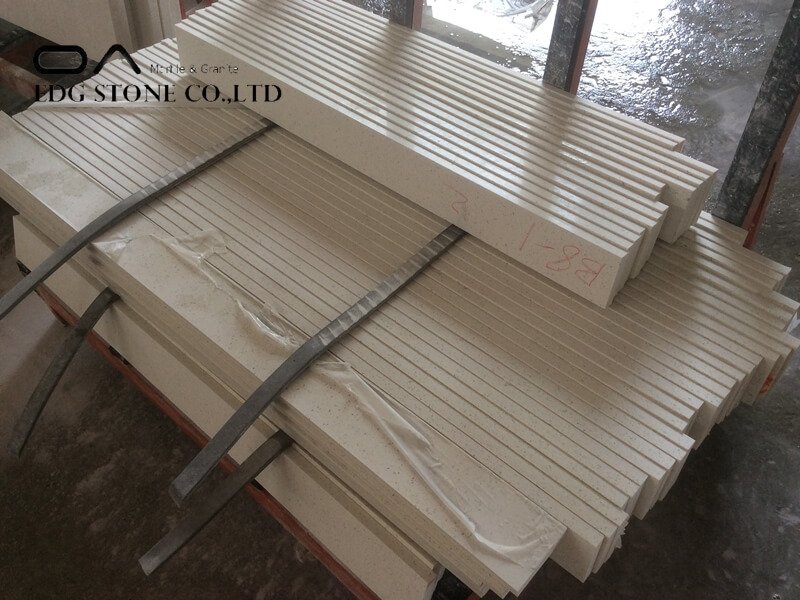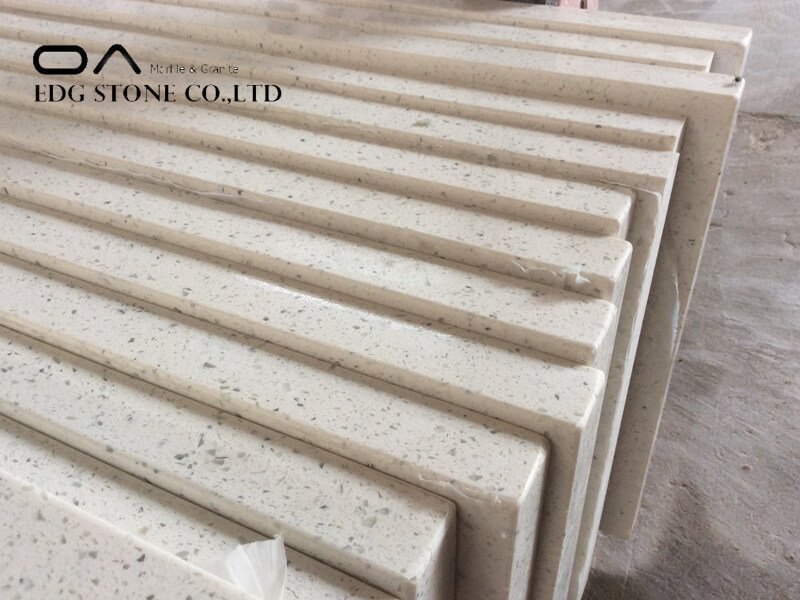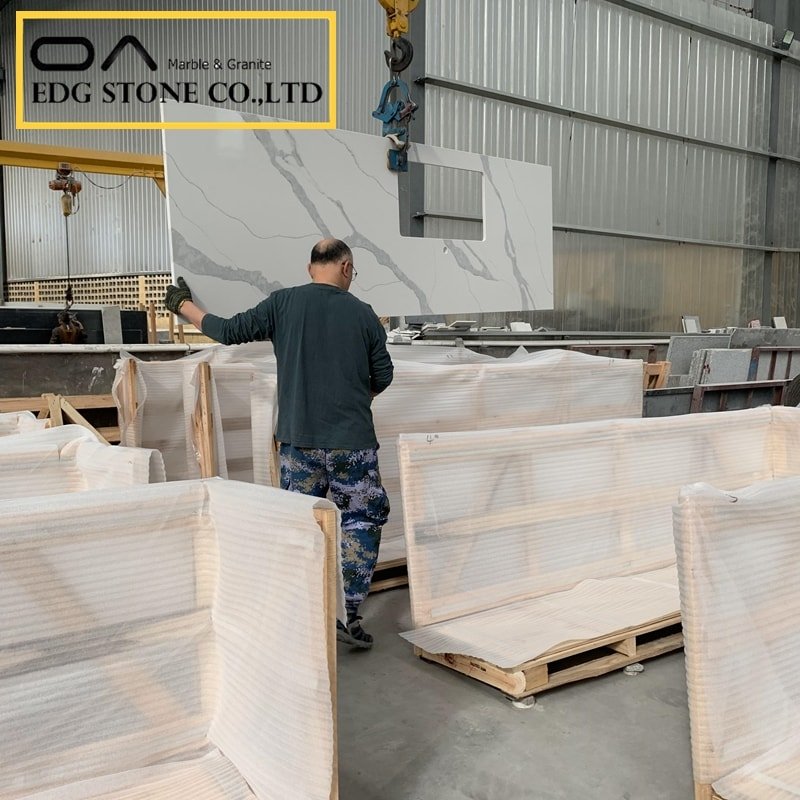The processing method of quartz stone is similar to natural granite, but it has a completely different method from the “artificial stone” commonly used in the market. All operations must be coordinated with cooling water.
First, storage and handling
1. Quartz stones must be stored indoors to avoid sunlight.
2. Use two A-type storage racks 1.5 meters apart. The bottom is padded with wooden strips, and the boards are flatly attached to the sideboards of the iron frame, and each board is tightly pushed against one side of no more than 25 boards.
3. In order to avoid bending and cracking of the table, do not place the finished product vertically.
4. The handling mentioned here refers to manual handling during the processing and installation process. All handling must be carried out by the method of standing the plate on the side. Two people stand on the side and move the plate to the front side of the machine or worktable, and then apply uniform force at the same time. Turn the floor over to lay flat on the machine or workbench. When the back is facing down, you can slowly drag the plate to adjust its position. When the front is facing down, it is strictly prohibited to drag the plate to avoid scratching the surface. The same is used for handling during the on-site installation. The principle is placed on the cabinet, and when necessary, 3-4 people can work together to complete the operation.
5. Three triangular iron frames (wood frames) are used for loading the large slab, 0.8 meters apart, wooden strips at the bottom, the length of the wooden strips is equal to the width of the car box, to prevent sliding, the large slab side is placed on the shelf, placed on both sides, and ensure The front of each board is to the front and the back to the back. The board must be pushed tightly, and then a soft rope (broadband) is used to bind the board. The rope is padded with paper to prevent damage or breakage caused by the sliding of the board due to transportation bumps.
6. The finished product is loaded with a triangular wooden frame, which must be fixed to the bottom of the car to prevent sliding. The finished product is placed on the wooden frame side by side, placed on both sides, and then tied to the wooden frame with a soft rope (wideband) to prevent the sliding of the bumpy board during transportation.
Second, Cutting (Note: All operations must be coordinated with cooling water)
1. You must read the drawings before opening the material to avoid size errors, conceive how to open the order, and know-how to open the material, in accordance with the principle of meeting the requirements of the drawing and saving materials.
2. Before opening the large board, first check whether the remaining materials are suitable for use, and check whether the colors are consistent, and visually check whether there are defects on the board surface.
3. The plates must be carefully checked before cutting to see if there is any color difference. For plates with cracks and defects, it should be clear whether they can be avoided during the processing so that no spots will be found after completion, which may cause serious economic losses.
4. The cutting material is based on the principle that the utilization rate of the material reaches more than 90%, and the width of the remaining material can exceed 58mm.
5. Try to avoid the parallel connection of the back wall, and the front edge can be polished after proper connection.
6. The hand cutter can be used in conjunction with the trimming machine.
7. Ensure that there is a 3-5mm expansion gap on the wall.
8. The cutting speed is 4m/min.
9. After cutting the material, check the size of each plate against the drawing. The section position, auxiliary materials, single number, address, and joint should be clearly written, and the next process should be explained clearly.
Third. Sticky edges (Note: All operations must be coordinated with cooling water)
1. The products passed from the previous process must be inspected, and unqualified products should be rejected.
2. Before the table is glued, you must read the drawing, understand the relationship between the joined table and the entire table, and receive the glue, straight edge, and front edge materials required for the table.
3. Set up a person to adjust the color of the glue. The color of the glue should be as close as possible to the color of the board. The adjusted glue must be approved by the team leader before the glue is used.
4. When using quick-drying glue, the ratio of glue to the curing agent should be added according to the instructions. It is strictly forbidden to add a large amount of curing agent to affect the firmness of the joint and the color variation. Strictly control the quantity of glue each time to avoid waste.
5. When sticking straight edges, the surface to be pasted should be thoroughly clean, dry, and smooth. Check the flatness of the joint surface on the back of the large plate. If necessary, use an angle grinder for subtle modification. Clean and dry the bonding surface, evenly apply the same color glue to the edge of the large bottom panel within 15mm, place the straight edge strip on the glue, and move it left and right to squeeze out the air. Use a clamp and a rubber hammer to clamp the straight edge strip with moderate force Align with the big board. Place clamps every 5-10 cm, and remove the glue spilled from the back after half-dry. After the edge strips are bonded (after drying), use the same color glue to connect the same color quartz stone reinforcement to connect the straight edges to the board surface, and finally use glass glue and other clips to bond the lined wood strips to the board (lay flat formula)
The bottom of all fixtures must be clamped under the wooden side of the workbench, and cannot directly touch the smooth surface. The bottom must be absolutely flat.
6. To join the front edge, first, use the quick-drying glue of the same color to fix the gold stone quartz stone reinforcement material to the bottom of the board according to the straight edge gluing method. After the glue is dry, evenly apply the same color glue to the back of the front edge, using moderately The strength of the rubber hammer is used to connect the front edge with the bonded reinforcement material to ensure the flatness of the protruding water line and the tight integration without gaps. When the glue is half dry, use a small blade to scrape off the overflow glue. Finally, use glass glue and clamps to smoothly bond the lined wooden strips to the board. (Flat type)
Note: When using a large clamp to clamp the front edge, the wooden strips must be longer than the board on both sides of the board, and the long clamp must not directly contact the two sides of the board.
Quadrilateral processing (Note: All operations must be coordinated with cooling water)
1. The products passed from the previous process must be inspected, and unqualified products should be rejected.
2. The edge processing includes back wall edge, straight edge, bevel edge, front edge, special-shaped edge, etc. All water-polished edges require a surface finish close to the original factory.
3. Straight edges such as the back wall, beveled edges, front edges, etc., are firstly ground with an edging machine. If manual edging is used, the linear deviation must be within 0.5mm, and it must be produced in strict accordance with the standards of the system.
4. Maintain the inherent shape of the edge of the board during water milling. Water milling only plays a role in polishing and cannot change its shape.
5. The use of 50, 100, 150, 300, 500, 800, 1000, 2000, 3000# water mills for edging must ensure that each water mill and each water mill are completely and thoroughly in place. The standard can be 50#, 150#, For 500#, 1000#, 2000# and 3000# six water mills, enough water should be given to each water mill to prevent blackening of the surface especially during fine grinding. The rotation speed of the mill is above 4000r.p.m.
6. When sanding, the bottom of the table must be straight and the height of multiple tables should be the same to prevent uneven height on both sides and the middle.
7. If necessary, use fine sandpaper for fine polishing.
Fifth, Holes (Note: All operations must be coordinated with cooling water)
After any openings are marked and positioned, they must be reviewed and confirmed by the team leader before cutting.
1. The products passed from the previous process must be inspected, and unqualified products should be rejected.
2. Read the size of the drawing before opening and marking, pay special attention to the relationship between the centerline or the sideline, and do not confuse the center line and the sideline.
3. The opening must be carried out on a wooden workbench with large surface support. Hanging operation is strictly prohibited to prevent cracks caused by moving off.
4. Water tap and gas hole:
Use a hand drill or percussion drill to install a diamond drill bit, fix the wood mold hole on the table, and slowly drill down the wood mold hole.
5. Stove, sink, and basin opening:
5.1. Leave a gap of 3mm on the four sides of the opening, and reserve a gap for expansion of accessories.
5.2. After the line is drawn on the board, in order to avoid the extension of the cutting line and the appearance of corner cracks, a hole above φ3cm must be drilled in the opening corner, and then use a hand cutter to cut along the inside of the hole, and keep it as large as possible The rounded corners are at the corners.
5.6. Use arc-shaped quartz stones to reinforce the four corners of the hole.
5.7. Use 25mm wide stone bars to reinforce around the hole.
All sinkholes, basin holes, and furnace holes on the counter must be drilled with three sinks, namely 50#, 150#, 500#, to ensure that the holes are smooth and free of teeth.
Six, cut corners
After any corners are cut and lined, they must be reviewed and confirmed by the team leader before cutting. All operations must be equipped with cooling water. After the line is drawn on the board, in order to avoid the extension of the cutting line and the appearance of corner cracks, a hole of φ3cm or more must be drilled in the corner of the cut corner, and then use a hand cutter to cut along the inside of the hole, And keep the rounded corner as large as possible at the corner. (The back wall can be covered)
All cut corners must be polished three times, namely 50#, 150#, 500#, to ensure that the edge of the hole is smooth and without cracks.
Seven, under counter basin processing
After opening the hole in the under-counter basin, first polish and polish the edge of the test basin, and then use the color toning super glue to tightly combine the edge of the basin and the countertop. (Note: the direction of the overflow and the drain) wipe the surface overflow with a clean cloth Finally, the remaining material (long strip) of quartz stone is reinforced on the bottom with the same color glue.
8. Processing of flat table tops and under-counter cushions
1. The products passed from the previous process must be inspected, and unqualified products should be rejected.
2. Read the drawings first, and be aware of the places where wooden slats and boards are needed.
3. When laying wooden strips or wooden boards under the joint surface, all dimensions should be calculated in place. Try to use the push table to process, avoid using jigsaw processing to saw the wooden strips or boards crookedly.
4. The bottom of the countertop should be cleaned before joining with the same color glue, and then placed in order to ensure that the wooden mat strip or wooden backing board is tightly combined with the countertop, and then glue on the contact surface is smooth and seamless. Use clamps when necessary. For the method of clamp use, please refer to the straight edge joint specification. Paste the wooden strips at equal distances from the front, middle, and back, and remove the excess glue when the glue of the same color is about to dry.
5. Clean all the stains on the countertops, wax the countertops that need to be waxed, and enter the finished product area for storage after quality inspection and approval.
Nine, packaging and transportation
1. Use a 2cm foam board to separate the board from the board to prevent accidental scratches.
2. When the finished product is installed and transported, it is fixed in the car with a wooden frame or an angle steel frame, and then the finished product is bundled on the shelf.
10. On-site construction and installation
1. Necessary tools for site construction and installation
1.1, angle grinder (a steel grinder)
1.2, water mill (resin grinding plate)
1.3, hand drill
1.4, screwdriver bit and diamond drill bit (φ35,φ25,φ15)
1.5, jigsaw
1.6, small blade
1.7, neutral glass glue (transparent, beige, white), caulking glue, dry hanging glue
1.8, marble glue (transparent, beige, white) curing agent
1.9, hardener, toner
1.10, triangular glass fixture
1.11, wiring socket
1.12, film and tape
2. Site construction and installation
2.1. Valuable items such as electrical appliances (range hood, dishwasher, oven, refrigerator) that have been installed on-site should be protected with film and tape.
2.2. Use a level to check the flatness of the kitchen cabinets on site. When installing, ensure that the bottom surface is absolutely flat. Check whether the countertop matches the size of the site. If there is an error, correct it.
2.3. A gap of 3.5mm between the edge of the countertop and the wall must be ensured, and the adjustment during installation and the expansion of the countertop by thermal expansion and contraction should be used, and the gap should be filled with adhesive (glass glue, etc.).
2.4. After placing the countertop and back wall, perform partial adjustment and modification, and tap to check whether there is any dangling. Small dangling can be padded with adhesive glue at the bottom. If it is severely uneven, stop the installation, adjust the kitchen cabinet or trim the countertop Until it is leveled.
2.5. Remove the adjusted countertop, and apply adhesive (glass glue, etc.) on the side panel where the under-counter mat and the kitchen cabinet are connected.
2.6. When large surface joints are required on-site for L-shaped countertops or extra-long countertops, if necessary, strong glass clamps can be used to clamp the two large surfaces and squeeze the gap. The joints must be clean and dry, and the colored glue should be evenly applied to For the part that needs to be seamed, when pressing the two countertops, moves the countertop back and forth to squeeze the gap to be small and neat, and ensure the flatness between the two boards. After about 10-15 minutes, use a small blade to scrape off the seam Glue oozing from the surface.
Special mention is that it is not advisable to polish the surface of the joint, especially the dark color series. Polishing is absolutely prohibited. Polish the surface and use a 100mm wide residual material under the joint to enhance the warranty.
2.7. Use bonding glue (glass glue, etc.) to bond the back wall, and evenly spread the color-adjusted bonding glue on the bottom of the back wall, place the back wall on the cabinet surface, and then rub the back wall left and right, about 10-15 Wipe off the leaking glue within minutes, and do not use the same color glue to connect the back wall, because the adhesive (glass glue, etc.) have a certain toughness and will not cause cracking or fracture.
2.8, after about 10-15 minutes, you can wipe off the excess adhesive with water or detergent.
2.9. Try to avoid opening holes on site. If you want to open holes, you must strictly follow the opening method specified by the company. The bottom must be supported and the corners must be rounded. If you want to open a hole, you must stick it on the back wall after connecting.
2.10. Use a blade to scrape off the residual glue on the surface and clean it thoroughly.
2.11. Glass glue is commonly available in white, black, and transparent. If customers really need to polish the surface of large-surface joints (light color series), the joint glue can be changed to dry hanging marble glue (quick drying) ( Brand recommendation: EPOXY). Adhesive glue (glass glue, etc.) glue should have anti-mildew and antibacterial, which can reduce the blackening of the glue.









